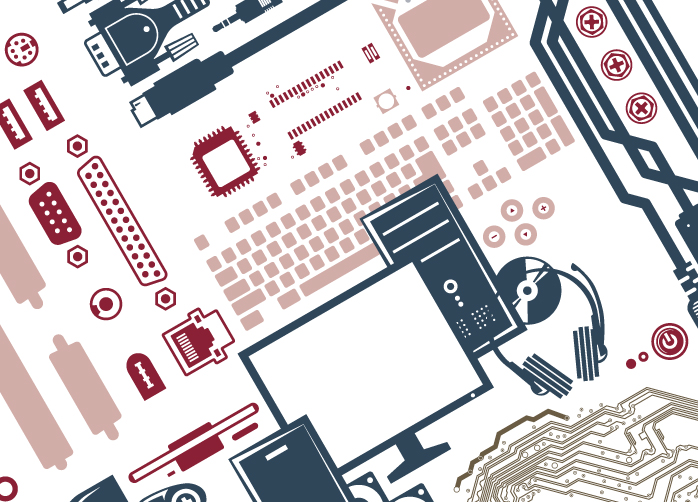Website design has come a long way since the late 1990s: Don’t believe us? Just take a quick trip to any good digital archive website and type in your favourite website addresses: It might shock you to notice just how terrible some of those sites (Even the ones belonging to big-time brands) looked back then: And no, we’re not just talking about shocking colour-schemes, poor logo designs or cheesy graphical effects…

Web technology has evolved at a blistering pace: In fact, the web of today would be barely recognisable to any time travellers from the 1990s, for a number of key reasons…
The average modern internet connection is a lot quicker than what was available back then
Part of the reason why many sites of old look so awful to modern eyes was the fact that they typically found their way to users’ CRT displays via painfully slow 56k dial-up connections (for the luckier users) and as a result, site designers were faced with a constant battle to keep the file size down for each page that they created. To help achieve lower sizes, images would typically be gritty, heavily-compressed .GIFs.
Combine this with the fact that control over fonts and general styling of site elements was limited at best – and you don’t exactly have a recipe for dazzling results. Such limitations meant that, unless some clever coding or minimalistic design was applied, the end results would often look horrendous, especially when a designer attempted to get overly ambitious.
Beyond looks, fast connection speeds have allowed modern websites to have many more features than sites of old: Online maps, on-demand movies, social media feeds and cloud storage to name but a few web technologies would simply not work effectively if everyone was still using 56k modems.
All in all, internet connection speeds may have freed up designers from a number of roadblocks – but aside from the brief phase of graphics and animation heavy (Often flash-based) websites which were all the rage on the net a decade ago, a more minimalistic approach is generally favoured over multimedia overkill these days: It all boils down to the simple fact that just because you can, doesn’t always mean that you should!
Older websites were optimised for low-resolution displays
One other important fact relating to hardware is that monitors back in the day would typically have pretty low resolutions…thus, websites had to be coded up to display effectively on an 800x600px screen: To put that into perspective, some smartphones today have displays of 2560 x 600px, with increasingly higher resolutions being offered all the time.
When looking at an old website design on a modern monitor, it might look a lot worse than it would have done on its older contemporary equipment: If anything, it would look like someone has shrunken the site down: On lower resolution displays, the website would occupy a lot more of the screen real-estate, with text and icons appearing significantly larger, but even then, the low-quality, grainy graphics would stand in stark contrast to the high-quality images that we are used to today.
Today’s responsive sites are designed to display effectively across a wide range of resolutions and aspect ratios: Even when fixed-width, non-responsive designs are used, the baseline resolution is generally well above the traditional 800 x 600px of the 90s, meaning the way that sites look has, in many ways, changed, as a reaction to the availability of improved display technology.
Form factors have changed
Back in the late 1990s, you really only had two options when it came to connecting to the net: A beige behemoth of desktop computing tech or a chunky (by today’s standards), most likely very expensive laptop: In both cases, interaction with websites would have been via a mouse/trackball and keyboard combo, on a relatively small, low resolution display.
Fast forward to the present day and the amount of internet-enabled, high-res devices is simply mind-boggling: From the much more powerful versions of traditional desktops and laptops available now, to tablets, smart-phones, smart-TVs, games consoles and even wearables like smart-watches and Google glass, we are living in an age where the net is pretty much everywhere. In such an environment, websites have to be responsive – and also allow for interaction via touch-screen interfaces, voice commands and more.
The fact that so many different kinds of devices are now used en masse across the globe means that websites today have to be designed to adapt and react to a wide range of variables: Just another way in which hardware has shaped the way in which web design is carried out today.
- Which mobile-friendly web design strategy is right for you? - August 28, 2015
- Errors to avoid in your social media marketing campaign - August 26, 2015
- Three things you must get right to run a successful e-com store - August 20, 2015
- Focus on the smallest details for a more mobile-friendly site - August 18, 2015
- Three reasons why physical retailers need an online presence - August 14, 2015
- Could your Scottish start-up benefit from a new digital grant? - August 13, 2015
- Does Google care if your website is responsive or not? - August 11, 2015
- Three powerful tips to boost your ecommerce conversions - June 15, 2015
- How Googles algorithm changes influence web design - June 7, 2015
- Stay on top of your Social Media Marketing with these 3 tips - June 2, 2015
You may also be interested in:
- The 1990s called: They want their website back… In the accompanying post ‘Three ways that hardware has affected website design since the 1990s’, we took a look at...
- 3 Things to Consider When Hiring a Web Design Company You've decided your business needs a website or that it needs a new one. This is a big step for...
- Why has everything gone flat in web design? These days, websites need to display their content and navigation effectively across a wide range of devices: In a world...
- Getting your website design balance right As with so much in life, website design involves making a lot of decisions: Today we take a look at...
- Does your website really need to be ‘responsive’? With all the recent chatter about 'responsive web design' that has been hitting the net in recent years, it's time...





